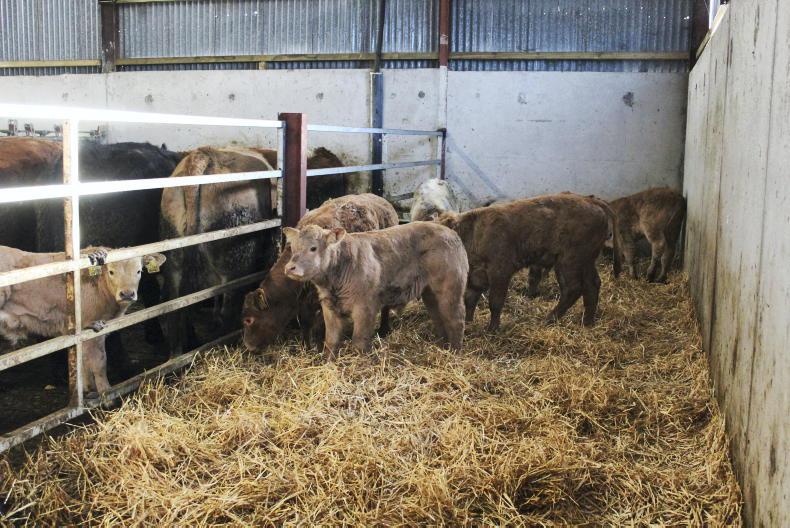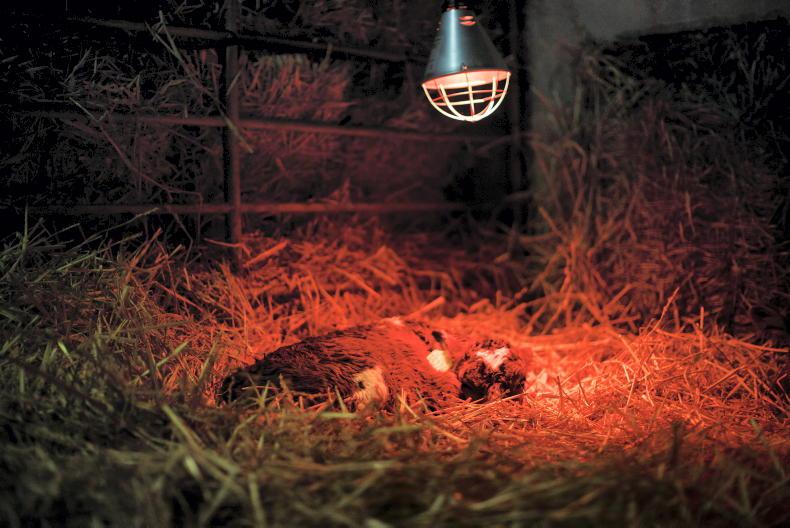Scour is caused by damage to the gut wall and leads to a lack of absorption of fluids, salts and nutrients.
The damage can be caused by viruses, parasites and bacteria, and often more than one of these affect the calf at the same time.
Cryptosporidium and rotavirus are common causes of scour in young calves, while coccidiosis generally affects calves older than three weeks.
It is not possible to tell what the cause is by the look of the scour. The treatment and control options can differ according to the cause, so it is important to get a diagnosis if there are repeated bouts of scour or many animals are affected.

Adequate straw bedding is very important in reducing the incidence of disease outbreaks on farms.
Your veterinary practitioner can advise on steps to take but it usually involves taking a sample of the diarrhoea. These samples should be taken early in the outbreak for the best chance of finding the cause – the first day of the scour – and from a number of animals.
The main causes of scour are usually not bacterial so antibiotics will be ineffective in these cases, unless the calves show other signs of a generalised infection.
Very weak or depressed calves, those with a high temperature or those refusing to drink at several consecutive feeds should be seen by a veterinary practitioner who can advise on further treatment.
The mainstay of treatment for scouring calves is the same, no matter the cause: remove, rehydrate and feed milk.
Remove the calf from the group to prevent the spread of infection and place them in a warm, dry environment. Clean the bedding or top up with straw regularly to ensure it stays dry where the calf is lying, as cold and wet conditions will suppress a calf’s immune system. Suckler calves should be kept with their dams and both removed from the main group. Rehydrate the calves by feeding oral rehydration/electrolyte fluids. Give one or two extra feeds daily (two litres each) of a good-quality oral rehydration fluid for as long as the calf continues to scour, at a different time of day to the milk feeding. Rehydration fluids can be safely given by stomach tube if needed. Continue to feed and offer normal amounts of milk or milk replacer while the calf is willing to drink. Suckler calves should stay with their dams to drink. Milk does not worsen or prolong the scour and can help the healing of the gut. Do not stomach-tube milk or milk replacer as this will enter the rumen and not be digested well. Good hygiene practices are critical, especially when handling sick calves. Cryptosporidium, for example, can be spread by equipment or clothing soiled with dung.
Ensure that calves receive adequate, good-quality colostrum (three litres) within the first two hours of birth
Those in contact with calves should wash their hands and boots after handling them. Ideally use different protective clothing and equipment (feeding buckets, bottles, etc) for sick and healthy groups of animals, or at the very least, wash them well between use. Feed healthy calves first and then handle sick animals to prevent contamination.
General prevention measures can help to keep calves healthy. Ensure that calves receive adequate, good-quality colostrum (three litres) within the first two hours of birth, which will bolster their immune systems to handle minor infections.
Scour vaccines given to the dam before calving are available for certain causes of scour and should be considered for repeated problems on-farm.
Hygiene, such as changing clothing, after handling sick calves can help to prevent the spread of infection to family members
Calving and calf-rearing pens should be thoroughly washed, disinfected and left to dry, free of animals for three to four months, in advance of the next calving season. Cryptosporidium is particularly hardy in the environment and only a few disinfectants are effective against it.
Cryptosporidium also affects people, especially young children or immunocompromised individuals.
Hygiene, such as changing clothing, after handling sick calves can help to prevent the spread of infection to family members and children should not be allowed to care for sick calves.
Complying with the regulations around slurry storage and disposal will also reduce the risk of water supplies becoming contaminated with Cryptosporidium oocysts.
Go to animalhealthireland.ie for more information.
Continue milk feeding if the calf is willing to drink.Feeding electrolyte fluids is the most important treatment for a calf that is scouring.Hygiene is important to prevent the disease spreading from sick to healthy calves.Antibiotics are generally not required for mild cases; your veterinary practitioner will prescribe these when needed.For ongoing problems with scour, investigate your colostrum management, nutrition and hygiene practices and seek a veterinary diagnosis. There is no single solution to prevent scour but many small management changes can keep it under control.
Scour is caused by damage to the gut wall and leads to a lack of absorption of fluids, salts and nutrients.
The damage can be caused by viruses, parasites and bacteria, and often more than one of these affect the calf at the same time.
Cryptosporidium and rotavirus are common causes of scour in young calves, while coccidiosis generally affects calves older than three weeks.
It is not possible to tell what the cause is by the look of the scour. The treatment and control options can differ according to the cause, so it is important to get a diagnosis if there are repeated bouts of scour or many animals are affected.

Adequate straw bedding is very important in reducing the incidence of disease outbreaks on farms.
Your veterinary practitioner can advise on steps to take but it usually involves taking a sample of the diarrhoea. These samples should be taken early in the outbreak for the best chance of finding the cause – the first day of the scour – and from a number of animals.
The main causes of scour are usually not bacterial so antibiotics will be ineffective in these cases, unless the calves show other signs of a generalised infection.
Very weak or depressed calves, those with a high temperature or those refusing to drink at several consecutive feeds should be seen by a veterinary practitioner who can advise on further treatment.
The mainstay of treatment for scouring calves is the same, no matter the cause: remove, rehydrate and feed milk.
Remove the calf from the group to prevent the spread of infection and place them in a warm, dry environment. Clean the bedding or top up with straw regularly to ensure it stays dry where the calf is lying, as cold and wet conditions will suppress a calf’s immune system. Suckler calves should be kept with their dams and both removed from the main group. Rehydrate the calves by feeding oral rehydration/electrolyte fluids. Give one or two extra feeds daily (two litres each) of a good-quality oral rehydration fluid for as long as the calf continues to scour, at a different time of day to the milk feeding. Rehydration fluids can be safely given by stomach tube if needed. Continue to feed and offer normal amounts of milk or milk replacer while the calf is willing to drink. Suckler calves should stay with their dams to drink. Milk does not worsen or prolong the scour and can help the healing of the gut. Do not stomach-tube milk or milk replacer as this will enter the rumen and not be digested well. Good hygiene practices are critical, especially when handling sick calves. Cryptosporidium, for example, can be spread by equipment or clothing soiled with dung.
Ensure that calves receive adequate, good-quality colostrum (three litres) within the first two hours of birth
Those in contact with calves should wash their hands and boots after handling them. Ideally use different protective clothing and equipment (feeding buckets, bottles, etc) for sick and healthy groups of animals, or at the very least, wash them well between use. Feed healthy calves first and then handle sick animals to prevent contamination.
General prevention measures can help to keep calves healthy. Ensure that calves receive adequate, good-quality colostrum (three litres) within the first two hours of birth, which will bolster their immune systems to handle minor infections.
Scour vaccines given to the dam before calving are available for certain causes of scour and should be considered for repeated problems on-farm.
Hygiene, such as changing clothing, after handling sick calves can help to prevent the spread of infection to family members
Calving and calf-rearing pens should be thoroughly washed, disinfected and left to dry, free of animals for three to four months, in advance of the next calving season. Cryptosporidium is particularly hardy in the environment and only a few disinfectants are effective against it.
Cryptosporidium also affects people, especially young children or immunocompromised individuals.
Hygiene, such as changing clothing, after handling sick calves can help to prevent the spread of infection to family members and children should not be allowed to care for sick calves.
Complying with the regulations around slurry storage and disposal will also reduce the risk of water supplies becoming contaminated with Cryptosporidium oocysts.
Go to animalhealthireland.ie for more information.
Continue milk feeding if the calf is willing to drink.Feeding electrolyte fluids is the most important treatment for a calf that is scouring.Hygiene is important to prevent the disease spreading from sick to healthy calves.Antibiotics are generally not required for mild cases; your veterinary practitioner will prescribe these when needed.For ongoing problems with scour, investigate your colostrum management, nutrition and hygiene practices and seek a veterinary diagnosis. There is no single solution to prevent scour but many small management changes can keep it under control. 






 This is a subscriber-only article
This is a subscriber-only article











SHARING OPTIONS: